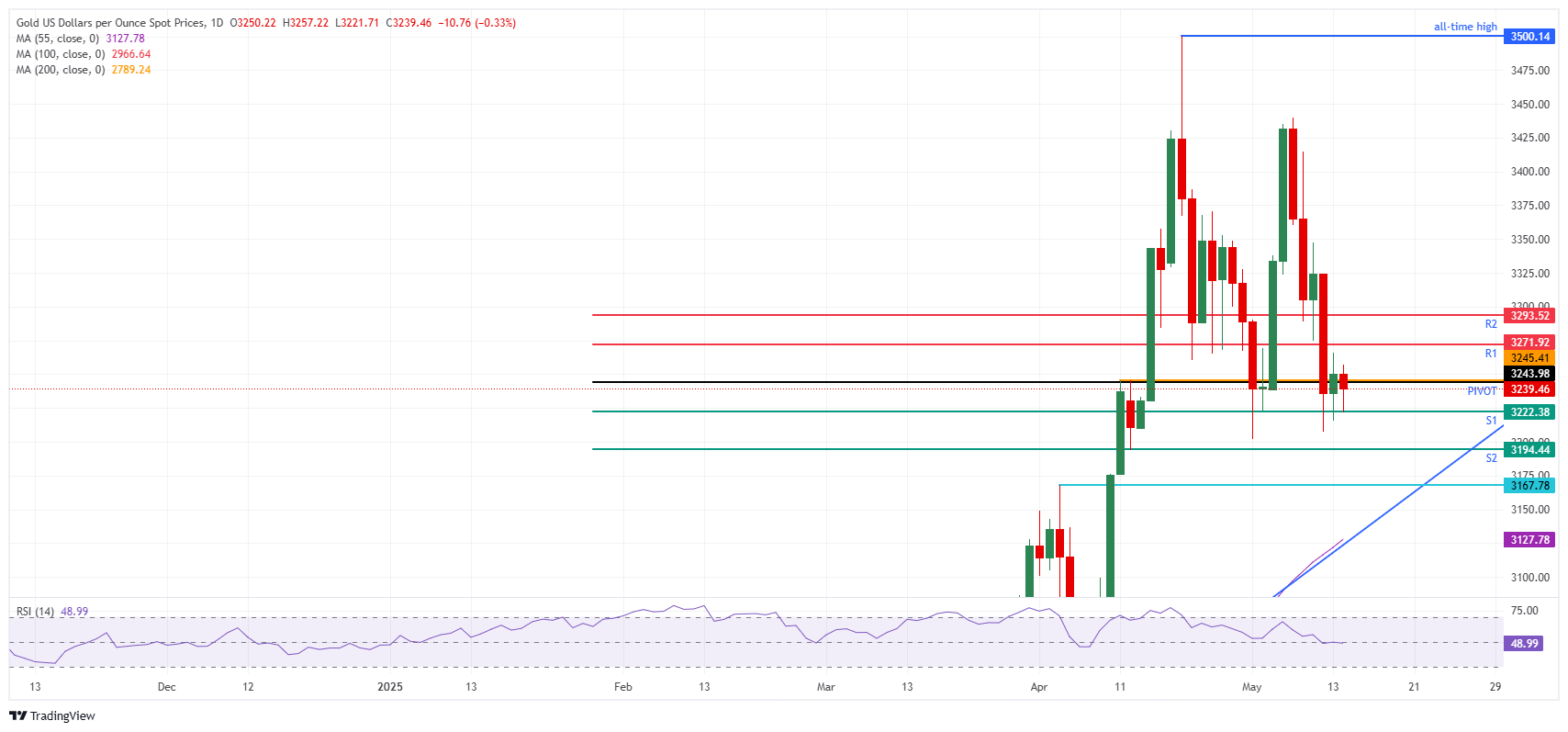Gold retreats slightly, failing to benefit from US dollar weakness
- Gold price erases Monday’s gains and flips this week’s performance to a loss.
- Traders are mulling the outlook for interest-rate cuts from the Fed while balancing the risks in equities.
- More downside for Gold could come if President Trump announces more trade deals.
Gold (XAU/USD) dips back to $3,225 on Wednesday as it faces renewed outflows, erasing almost all the gains registered on Tuesday. Softer-than-expected inflation data for April released on Tuesday provided a sigh of relief for markets, with the widely-feared inflation shock from tariffs not materializing yet. The softer-than-expected reading for both the monthly Headline and core components boosted a relief rally in equities and led investors to price in more Federal Reserve (Fed) rate cuts for this year.
Without any top-tier data releases for Wednesday in the Economic Calendar, markets will look for further clues after President Donald Trump visited Saudi Arabia and secured $600 billion in trade deals. On Thursday, Ukrainian President Volodymyr Zelenskyy is said to be ready to meet Russian President Vladimir Putin in Istanbul for peace talks, although Putin hasn’t confirmed his attendance. Both Europe and the US have urged Putin to come to Istanbul, while new sanctions are being weighed as countermeasures if peace talks do not take place.
Daily digest market movers: Alaskan Gold Mine faces tariff risk
- Gold is facing more downside pressure, several analysts and Gold traders confirm to Bloomberg. “The US-China tariff rates surprised materially to the downside, which eases investor concerns around trade-driven growth risks,“ said Justin Lin, an analyst at Global X ETFs. “Capital is likely flowing out of defensive sectors and Gold," he added.
- Still, the Gold rally could possibly not yet be out of steam, according to Amy Lo, UBS head of wealth management in Asia. UBS Group AG’s rich clients are increasingly shifting away from US-dollar assets, turning instead to Gold, crypto and investments in China. “Gold is getting very popular,” Amy Lo said in an interview with Yvonne Man at Bloomberg’s New Voices event Tuesday in Hong Kong.
- India’s trade deficit likely narrowed to $18.9 billion in April from $21.5 billion in March. The contraction in the deficit was partly due to a drop in Gold imports – a surge in prices likely reduced demand for the metal. A sharp drop in crude Oil prices is also expected to lower Oil imports, countering a typical seasonal jump in volumes.
Gold Price Technical Analysis: Not breaking just yet
Despite the selling pressure on Wednesday, a fresh low for this week has not materialized as Monday’s low at $3,207 hasn’t been tested.. Gold appears to be in a consolidation stage, with lower highs and higher lows. Whichever gets broken first will see further follow-through towards either $3,300 or $3,200.
The daily Pivot Point at $3,243 needs to be reclaimed first in case of any recovery. In case of a breakout, out of the consolidation, the R1 at $3,271 will certainly be tested. Not for from there, the R2 at $3,293 is possibly the last level to offer firm resistance before entering the $3,300 area again.
On the downside, the daily S1 support at $3,222 already offered ample support in Asian trading. In case a breakout materializes, look for the S2 at $3,194 before the pivotal technical support at $3,167 will pop up.

XAU/USD: Daily Chart
Gold FAQs
Gold has played a key role in human’s history as it has been widely used as a store of value and medium of exchange. Currently, apart from its shine and usage for jewelry, the precious metal is widely seen as a safe-haven asset, meaning that it is considered a good investment during turbulent times. Gold is also widely seen as a hedge against inflation and against depreciating currencies as it doesn’t rely on any specific issuer or government.
Central banks are the biggest Gold holders. In their aim to support their currencies in turbulent times, central banks tend to diversify their reserves and buy Gold to improve the perceived strength of the economy and the currency. High Gold reserves can be a source of trust for a country’s solvency. Central banks added 1,136 tonnes of Gold worth around $70 billion to their reserves in 2022, according to data from the World Gold Council. This is the highest yearly purchase since records began. Central banks from emerging economies such as China, India and Turkey are quickly increasing their Gold reserves.
Gold has an inverse correlation with the US Dollar and US Treasuries, which are both major reserve and safe-haven assets. When the Dollar depreciates, Gold tends to rise, enabling investors and central banks to diversify their assets in turbulent times. Gold is also inversely correlated with risk assets. A rally in the stock market tends to weaken Gold price, while sell-offs in riskier markets tend to favor the precious metal.
The price can move due to a wide range of factors. Geopolitical instability or fears of a deep recession can quickly make Gold price escalate due to its safe-haven status. As a yield-less asset, Gold tends to rise with lower interest rates, while higher cost of money usually weighs down on the yellow metal. Still, most moves depend on how the US Dollar (USD) behaves as the asset is priced in dollars (XAU/USD). A strong Dollar tends to keep the price of Gold controlled, whereas a weaker Dollar is likely to push Gold prices up.

